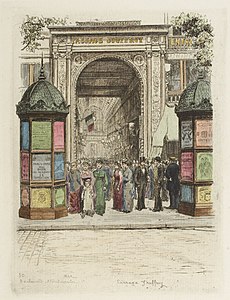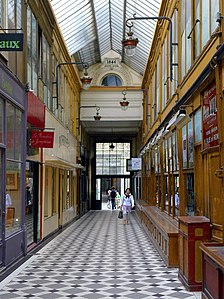Passage Jouffroy
| Joffroy passage | |
|---|---|
| location | |
| Arrondissement | 9. |
| quarter | Faubourg-Montmartre |
| Beginning | 10, Boulevard Montmartre |
| The End | 9, rue de la Grange-Batelière |
| morphology | |
| length | 140 m |
| width | 4 m |
| history | |
| Emergence | 1845-1847 |
| Coding | |
| Paris | 4911 |
The passage Jouffroy is a covered shopping arcade with a glass roof from the mid-19th century in the 9th arrondissement in Paris .
location
Passage Jouffroy is located between Rue de la Grange Batelière No. 9 and Boulevard Montmartre No. 10, in a mixed residential and business district on Grands Boulevards . In this district, a short distance from each other, you will find most of Paris' passages still intact: Passage Verdeau and Passage des Panoramas , both in the 9th arrondissement, Passage Brady and Passage du Prado , both in the 10th arrondissement , and Passage du Caire in the 2nd arrondissement . Arrondissement .
The Passage Jouffroy can be described as an extension of the Passage des Panorama and it is continued by the Passage Verdeau, because you leave one passage, cross a street and immediately enter the next passage. These three passages are lined up one behind the other and the idea of the 19th century to put the strollers in a special atmosphere in a specially created environment can still be experienced today.
The closest metro station is Grands Boulevards on lines 8 and 9 .
Name origin
The passage bears the name of the owner of the site, Félix de Jouffroy-Gonsans (1791–1863).
history
Passage Jouffroy, named after one of the builders who, together with others, also had Passage Verdeau built, was opened in 1847. The passage, designed by the architects François-Hippolyte Destailleur et Romain de Bourges , had to adapt to the difficult site, so that the first part, seen from the Grands Boulevards , ends at a staircase and the passage continues after five descending steps. This part of the passage is narrower and shorter.
The Passage Jouffroy was the first to be built entirely of steel and with a glass roof . Only the decorative elements are made of wood and the underfloor heating was also a novelty. One decorated with stucco is the eye-catcher of the passage. Since the renovation in 1987 it has found its old charm.
In 1974 the passage was added to the list of Monument historique . The passage was completely renovated in 1987, with the floor being tiled in the original way.
Attractions
In 1882, the Musée Grévin , named after the famous cartoonist Alfred Grévin , was opened right next to the Passage Jouffroy . The exit of the museum is in the passage, so visitors have to continue their way in the passage.
The passage in 1877 (drawing by A.-P. Martial )
Entrance from Boulevard Montmartre .
Entrance to the Grévin Museum .
The passage towards Rue de la Grange-Batelière .
literature
- Jean-Claude Delorme, Anne-Marie Dubois: Passages couverts parisiens . Parigrams, Paris 2002 (1st edition Paris 1996), ISBN 2-84096-264-0 .
- Bertrand Lemoine : Les passages couverts en France . Délégation à l'Action Artistique de la Ville de Paris, Paris 1990, ISBN 2-905118-21-0 .
Individual evidence
- ^ Jean-Claude Delorme et Anne-Marie Dubois, Passages couverts parisiens , Parigramme, 2002, 192 pp., ISBN 2-84096-264-0 , pp. 120–129
- ↑ Passage Jouffroy (voir aussi: musée Grévin) in the Base Mérimée of the French Ministry of Culture (French)
Web links
- Passage Jouffroy in the Base Mérimée of the French Ministry of Culture (French)
- Jouffroy Passage Jouffroy. In: Structurae
- Presentation on www.Insecula.com (with photographs)
- Passage Jouffroy in Paris Enigmes
Coordinates: 48 ° 52 ′ 21.2 " N , 2 ° 20 ′ 31.7" E






